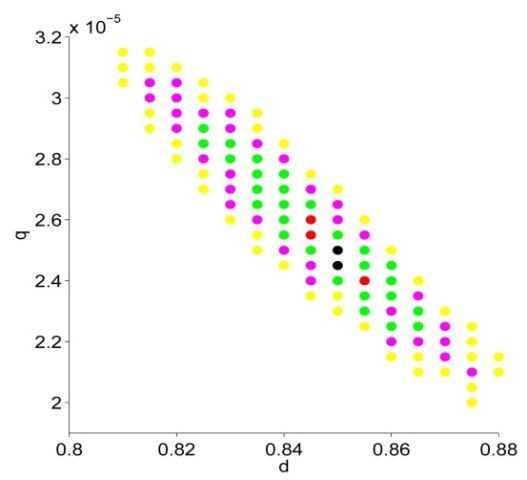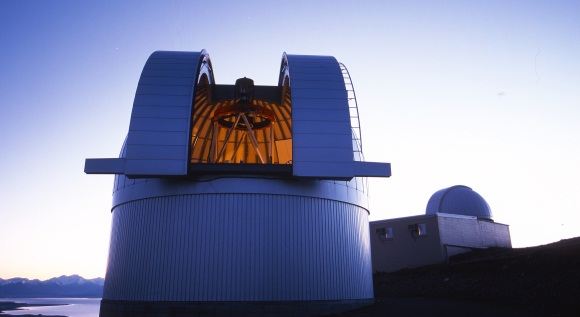
Planet hunting
Philip Yock, Department of Physics
Using microlensing to detect planets
Astronomers and philosophers have long thought about planets like ours, possibly inhabited, orbiting the stars of the night sky. Assuming the solar system is typical, a rough estimate of planets in the Milky Way would be around one trillion. Confirming this prediction has, however, turned out to be far from trivial.
The first planet to be found orbiting a star like the Sun was not found until 1995. The reason is straightforward. If we attempt to see a planet like Earth orbiting a star like the Sun, we need to search very close to the star, because even the nearest stars are at vast distances. The proximity of the planet to its host star implies it is lost in the glare of the star. For this reason, indirect detection methods are required.
New Zealand astronomers have been largely responsible for pioneering a planet detection technique which utilises the bending of light by the gravitational field, an effect that was predicted by Einstein early last century.
The method is illustrated as Figure 1. If two stars are aligned, as seen from Earth, then the nearer one acts as a gravitational “lens” of the more distant one. If planets orbit the lens star, their gravitational fields can perturb the lensing action to a detectable degree.
NZ astronomers using the microlensing technique are members of international collaborations known variously as MOA, MicroFUN and PLANET. Of these groups, MOA has the largest presence in New Zealand with members from Auckland, Massey and Canterbury universities.

Figure 1: The bending of light in the gravitational field of a star leads to the formation of an Einstein ring. The size of the Einstein ring is comparable to that of typical planetary systems. It is therefore possible for planets orbiting the “lens” star to betray their presence by perturbing the ring.

Figure 2. Series of over one hundred trials showing colour coded chi square values that was carried out in one night’s computing on the Pan. The results would have taken some months to obtain on a single PC. They were published in a paper on the detectability of Earth-like planets that appeared in the Monthly Notices of the Royal Society,
Vol 431, pp 2975-2985 (2013).
Simulating light rays
All stars are in motion. The formation of an Einstein ring is therefore a transient phenomenon only, visible for a matter of days. As two stars move into and out of alignment, the effect grows and subsequently diminishes. The effect of planets on the lensing process is most easily seen when the alignment is highest. The NZ groups have made good use of this seemingly self-evident effect. Analysing data on these “microlensing events” is not straightforward. It is very much a multi-parameter problem with at least five, ten or fifteen parameters that need to be varied to find the best match to the data.
At the University of Auckland a ‘ray shooting’ method has been devised. In this, simulated light rays are shot through an assumed lens system configuration, rather like optical lens designers do, and the computed image is compared with observation. Very large numbers of trials are made especially for a lens systems with multiple planets. Trials are made one at a time in a procedure that is parallelisable and ideally run on clusters of personal computers (PCs). The members of the MOA group at the University of Auckland have been very fortunate to receive much assistance with this. More recently, the Pan cluster became available which was used successfully by MSc student Matthew Freeman and summer scholar Charlotte Airey with assistance provided by Sina Masoud-Ansari. Some of their results appear Figure 2.
Future plans
The international microlensing community currently operate a growing number of telescopes, currently in excess of twenty, to monitor microlensing events. The quality of data being obtained with these telescopes is growing continuously and also the sophistication of the data analysis. Already several exotic discoveries have been made including the discovery of a large population of “free-floating” planets roaming interstellar regions in the Milky Way.
Further information
MOA: www.phys.canterbury.ac.nz/moa
MicroFUN: www.astronomy.ohio-state.edu/~microfun
PLANET: www.planet-legacy.org++

The telescopes used by the MOA group at the Mt John University Observatory in Canterbury. MOA is a Japan/NZ collaboration, and the nearer of the two telescopes shown above was supplied by Japan. With a diameter of 1.8m, it is the world’s largest telescope dedicated to microlensing.
See more case study projects

Our Voices: using innovative techniques to collect, analyse and amplify the lived experiences of young people in Aotearoa

Painting the brain: multiplexed tissue labelling of human brain tissue to facilitate discoveries in neuroanatomy

Detecting anomalous matches in professional sports: a novel approach using advanced anomaly detection techniques

Benefits of linking routine medical records to the GUiNZ longitudinal birth cohort: Childhood injury predictors

Using a virtual machine-based machine learning algorithm to obtain comprehensive behavioural information in an in vivo Alzheimer’s disease model

Mapping livability: the “15-minute city” concept for car-dependent districts in Auckland, New Zealand

Travelling Heads – Measuring Reproducibility and Repeatability of Magnetic Resonance Imaging in Dementia

Novel Subject-Specific Method of Visualising Group Differences from Multiple DTI Metrics without Averaging

Re-assess urban spaces under COVID-19 impact: sensing Auckland social ‘hotspots’ with mobile location data

Aotearoa New Zealand’s changing coastline – Resilience to Nature’s Challenges (National Science Challenge)

Proteins under a computational microscope: designing in-silico strategies to understand and develop molecular functionalities in Life Sciences and Engineering

Coastal image classification and nalysis based on convolutional neural betworks and pattern recognition

Determinants of translation efficiency in the evolutionarily-divergent protist Trichomonas vaginalis

Measuring impact of entrepreneurship activities on students’ mindset, capabilities and entrepreneurial intentions

Using Zebra Finch data and deep learning classification to identify individual bird calls from audio recordings

Automated measurement of intracranial cerebrospinal fluid volume and outcome after endovascular thrombectomy for ischemic stroke

Using simple models to explore complex dynamics: A case study of macomona liliana (wedge-shell) and nutrient variations

Fully coupled thermo-hydro-mechanical modelling of permeability enhancement by the finite element method

Modelling dual reflux pressure swing adsorption (DR-PSA) units for gas separation in natural gas processing

Molecular phylogenetics uses genetic data to reconstruct the evolutionary history of individuals, populations or species

Wandering around the molecular landscape: embracing virtual reality as a research showcasing outreach and teaching tool
























































































































































